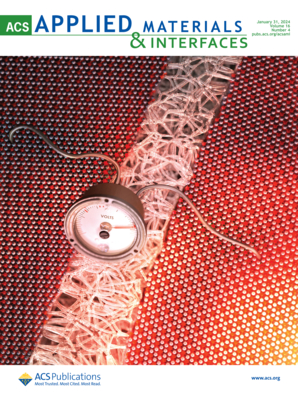Understanding Nanoconfinement Effects on Electrochemical Redox Reactions with Reduced Graphite Oxide as a Model Electrode
IF 8.3
2区 材料科学
Q1 MATERIALS SCIENCE, MULTIDISCIPLINARY
引用次数: 0
Abstract
Micropores smaller than 1 nm in carbon materials have garnered significant attention for their ability to induce confinement effects. Anomalous improvements in the specific capacitance and reversibility of electrochemical redox reactions have been reported. However, due to limitations in synthetic methods, carbon materials with identical physical properties but varying pore sizes have not yet been successfully prepared. In this study, we investigate the relationship between the pore size of carbon materials and the reversibility of the redox reaction of quinone-based molecules using reduced graphite oxide (rGO) as a model electrode material. Cross-linked graphite oxide (GO) and rGO exhibit minimal changes in surface properties while allowing precise tuning of the interlayer distance at the ångström level. The ΔEp values of the redox reaction of quinone-based molecules on cross-linked rGO decrease with decreasing interlayer distance. These findings strongly indicate that the reversibility of the redox reaction can be enhanced by reducing the pore sizes of carbon materials. This study clearly demonstrates the origin of the relationship between the pore size and reversibility of the redox reactions of quinone-based molecules.

纳米约束对还原氧化石墨模型电极电化学氧化还原反应的影响
碳材料中小于1nm的微孔因其诱导约束效应的能力而引起了人们的广泛关注。在电化学氧化还原反应的比电容和可逆性方面有异常的改善。然而,由于合成方法的限制,具有相同物理性质但不同孔径的碳材料尚未成功制备。在这项研究中,我们以还原氧化石墨(rGO)作为模型电极材料,研究了碳材料的孔径与醌基分子氧化还原反应的可逆性之间的关系。交联氧化石墨(GO)和氧化石墨烯(rGO)表现出最小的表面性质变化,同时允许在ångström水平上精确调整层间距离。醌类分子在交联氧化石墨烯上的氧化还原反应ΔEp值随着层间距的减小而减小。这些发现有力地表明,通过减小碳材料的孔径,可以增强氧化还原反应的可逆性。本研究清楚地揭示了孔洞大小与醌类分子氧化还原反应可逆性之间关系的起源。
本文章由计算机程序翻译,如有差异,请以英文原文为准。
求助全文
约1分钟内获得全文
求助全文
来源期刊

ACS Applied Materials & Interfaces
工程技术-材料科学:综合
CiteScore
16.00
自引率
6.30%
发文量
4978
审稿时长
1.8 months
期刊介绍:
ACS Applied Materials & Interfaces is a leading interdisciplinary journal that brings together chemists, engineers, physicists, and biologists to explore the development and utilization of newly-discovered materials and interfacial processes for specific applications. Our journal has experienced remarkable growth since its establishment in 2009, both in terms of the number of articles published and the impact of the research showcased. We are proud to foster a truly global community, with the majority of published articles originating from outside the United States, reflecting the rapid growth of applied research worldwide.
 求助内容:
求助内容: 应助结果提醒方式:
应助结果提醒方式:


